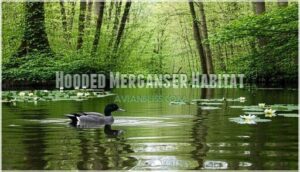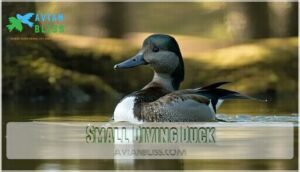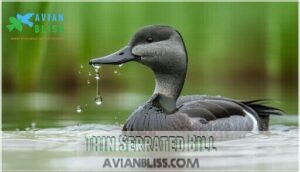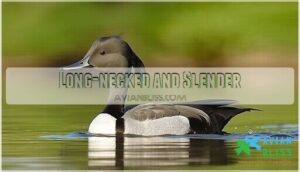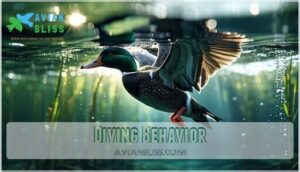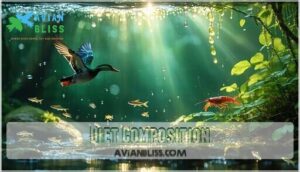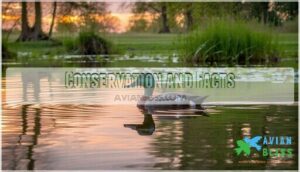This site is supported by our readers. We may earn a commission, at no cost to you, if you purchase through links.
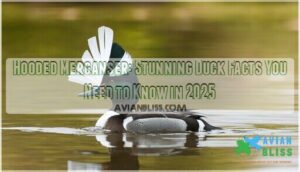
This smallest North American merganser species packs serious diving skills, plunging underwater for up to two minutes to snag fish with its thin, serrated bill.
These compact hunters prefer quiet ponds and wooded swamps where they can showcase their underwater acrobatics.
Males sport striking black-and-white plumage with that iconic white crest patch, while females rock a more subdued cinnamon-colored look.
They’re surprisingly speedy fliers too, hitting 50 mph when they need to make a quick exit.
What really sets these remarkable ducks apart goes beyond their flashy appearance.
Table Of Contents
- Key Takeaways
- Hooded Merganser Habitat
- Physical Characteristics
- Feeding and Diving
- Breeding and Nesting
- Conservation and Facts
- Frequently Asked Questions (FAQs)
- How rare is a hooded merganser?
- Are hooded merganser good to eat?
- What is the difference between a bufflehead and a hooded merganser?
- Where can I find a hooded merganser?
- Where do hooded mergansers migrate?
- Is a hooded merganser considered a duck?
- How long can hooded merganser stay underwater?
- What is the etymology of their name?
- How do they communicate with each other?
- What is the typical lifespan of Hooded Mergansers?
- Conclusion
Key Takeaways
- You’ll easily identify hooded mergansers by their fan-shaped crest that opens and closes dramatically – males sport striking black-and-white plumage with iconic white crest patches, while females display more subdued cinnamon coloring.
- These expert divers can stay underwater for up to two minutes while hunting fish – they use their thin, serrated bills like natural tweezers to grip slippery prey in depths up to 15 feet.
- You’ll find them in calm, wooded waterways like small ponds and marshes – they prefer tranquil waters that won’t disturb their diving activities and need tree cavities nearby for nesting.
- They’re surprisingly fast flyers, reaching 50 mph, and aren’t currently threatened – their populations have recovered well from early 1900s declines, though habitat loss remains an ongoing concern.
Hooded Merganser Habitat
You’ll find hooded mergansers in calm, wooded waterways where they can easily dive for fish and aquatic insects.
Hooded mergansers transform wooded waterways into underwater hunting grounds with their expert diving skills.
These stunning ducks prefer small ponds, marshes, and wooded swamps that offer both food and the tree cavities they need for nesting.
Prefer Calm Bodies of Water
When you spot a hooded merganser, you’ll notice they’re drawn to tranquil waters where river currents won’t disturb their diving activities.
These waterfowl birds thrive in calm lake ecosystems and sheltered pond life environments that support their hunting style.
Key habitat preferences include:
- Protected bays and coves – Shield merganser ducks from strong winds
- Shallow water depth areas – Typically 3-10 feet deep for ideal diving
- Dense aquatic plants coverage – Provides cover and attracts prey fish.
These aquatic birds avoid turbulent waters that make precise underwater navigation difficult for successful feeding.
The hooded merganser’s choice of habitat is influenced by their need for clear freshwater habitats to forage and breed effectively.
Nests Near Small Ponds
You’ll find hooded merganser duck waterfowl bird pairs choosing small ponds for their pond nesting adventures.
These merganser duck couples prefer ponds with stable water levels and abundant pond vegetation.
Duck habitat selection focuses on secluded nesting sites near woodland edges.
Merganser nesting success depends on proper nest materials like wood chips and leaves found around these intimate water bodies, which is crucial for their nesting success.
Marshes and Wooded Swamps
You’ll discover these merganser species thriving in marshes and wooded swamps where Wetland Ecosystems create perfect merganser habitat.
These water bird sanctuaries offer dense Aquatic Plants for cover and excellent Water Quality for diving.
Swamp Ecology provides the ideal duck habitat with shallow areas for merganser nesting, while Marsh Conservation efforts protect these essential environments where mergansers find abundant fish and invertebrates, supported by Aquatic Plants.
Migration Patterns
You’ll witness these water birds following predictable flyway routes during their seasonal moves.
Hooded mergansers showcase fascinating migration cycles that bird tracking reveals across North America’s major corridors. Their habitat and behavior are influenced by their role as visual predators.
Their habitat shifts follow these patterns:
- Mississippi Flyway – Most merganser species winter in south-central regions
- Atlantic Flyway – Eastern populations migrate to coastal Atlantic states
- Pacific Routes – Western birds move toward Pacific coastal areas
- Fall Timing – Duck migration peaks in November, returning by January
Physical Characteristics
You’ll easily recognize hooded mergansers by their distinctive crest that can fan out dramatically when excited or alarmed.
These compact diving ducks feature sleek, streamlined bodies with serrated bills perfectly designed for gripping slippery fish underwater.
Small Diving Duck
You’ll recognize these waterfowl as compact powerhouses, measuring just 16-19 inches long.
Their streamlined bodies cut through water like nature’s torpedoes, while powerful legs propel them beneath the surface.
Duck Behavior shows remarkable diving abilities – they vanish underwater for 10-60 seconds hunting prey.
These merganser characteristics make them exceptional waterfowl divers.
| Physical Feature | Measurement/Description |
|---|---|
| Body Length | 16-19 inches |
| Weight | 1.1-2.4 pounds |
| Wingspan | 24-26 inches |
| Diving Duration | 10-60 seconds |
| Water Depth | Up to 8 feet |
Thin Serrated Bill
You’ll notice the hooded merganser’s thin serrated bill serves as a specialized feeding mechanism perfectly designed for their aquatic lifestyle.
These unique bill anatomy features include tiny tooth-like projections along the edges that function like natural tweezers.
The serration purpose becomes clear when observing duck behavior – these merganser characteristics allow them to grip slippery fish and aquatic prey with remarkable precision.
This beak function represents millions of years of evolutionary refinement, making merganser diet incredibly diverse and efficient underwater, which is a result of their aquatic lifestyle.
Long-necked and Slender
You’ll spot the Hooded Merganser’s elegant neck structure and slender build immediately.
Their graceful body proportions create a streamlined silhouette that’s perfect for underwater hunting.
The elongated neck allows precise head movements while diving for fish and aquatic insects.
Here are 5 key features of their slender anatomy:
- Neck Structure – Exceptionally long and flexible for precise underwater maneuvering
- Slender Build – Compact body design reduces drag during high-speed dives
- Long Feathers – Streamlined plumage enhances their aerodynamic profile
- Body Proportions – Balanced frame optimizes both swimming and flight performance
- Head Shape – Small, pointed skull complements their overall sleek appearance
This merganser information reveals how their slender build supports their active lifestyle.
These merganser facts highlight why body proportions matter for duck identification – their lean frame distinguishes them from bulkier waterfowl species.
Understanding these bird species characteristics helps you appreciate how form follows function in nature’s design.
Fast Wingbeats
You’ll marvel at how these ducks power through the air with rapid, buzzing wingbeats that create distinctive flight patterns.
Their streamlined feather structure reduces air resistance, making them incredibly efficient fliers.
When bird watching, listen for the characteristic whirring sound their wings produce.
This aerodynamic design helps with duck identification, as merganser facts show their wingbeat speed exceeds most waterfowl.
Understanding bird species flight mechanics enhances your merganser information knowledge substantially.
The unique characteristics of their feather engineering play a vital role in their ability to fly efficiently, showcasing their efficient fliers capabilities and distinctive flight patterns.
Feeding and Diving
You’ll be amazed at how these skilled divers hunt for their meals beneath the water’s surface.
These underwater acrobats vanish beneath the surface like feathered torpedoes, emerging with dinner clutched in their serrated bills.
Hooded mergansers can stay underwater for up to a minute, using their excellent eyesight to spot fish, aquatic insects, and crustaceans in the depths.
Diving Behavior
You’ll watch hooded mergansers transform into underwater torpedoes as they execute perfect vertical dives.
Their dive speed reaches impressive velocities, with streamlined feather structure reducing drag during water entry. These skilled divers can hold their breath for 30-45 seconds, reaching foraging depths of 10-15 feet.
Bird photography enthusiasts often capture these dramatic plunges, making merganser images popular in ornithology circles and bird conservation efforts.
The use of Diving Duck Cameras can provide valuable insights into the behavior of these birds.
Feeding Habits
Patience becomes your greatest asset when studying hooded merganser feeding habits. These skilled hunters don’t rush their meals, carefully selecting prime feeding spots through strategic foraging strategies.
Their nutrient intake patterns fascinate ornithology researchers and birdwatching enthusiasts alike. Bird photography reveals these mergansers’ methodical approach to food sources, making them excellent subjects for diet analysis studies supporting bird conservation efforts.
Key Feeding Behaviors:
- Selective hunting – Target specific aquatic prey based on availability
- Dawn/dusk activity – Peak feeding during low-light periods
- Group coordination – Sometimes feed collectively for efficiency
- Dive timing – Brief underwater forays lasting 10-30 seconds
Diet Composition
Fish make up 44-81% of their food sources, while crustaceans contribute 22-50% seasonally.
You’ll find these nature enthusiasts consuming small minnows, sunfish, and crayfish to meet their protein requirements.
Their aquatic plants intake stays minimal compared to other ducks.
Insect consumption peaks during spring, supporting ecosystem balance.
This diverse nutrient intake helps maintain healthy wildlife populations and biodiversity conservation efforts.
The Hooded Merganser’s breeding habitats play a vital role in their survival and reproduction.
Breeding and Nesting
You’ll discover that hooded mergansers have fascinating breeding behaviors that set them apart from other waterfowl.
Their unique nesting preferences and parental care strategies make them one of North America’s most interesting duck species to observe during breeding season, with breeding season being a key time for observation.
Breeding Habits
You’ll witness spectacular courtship displays when breeding seasons arrive from late February through early June.
Male hooded mergansers perform impressive aerial somersaults and aggressive displays, raising their distinctive crests to attract females.
Their mating rituals peak in March and April, when pair bonds form on breeding grounds, and they practice seasonal monogamy.
Their focused parenting guarantees a dedicated approach, though males disappear once egg laying begins in their chosen habitat.
Nesting Sites
While hooded mergansers show flexibility in their nesting choices, you’ll discover they’re quite particular about their preferred spots.
These cavity-nesting ducks seek out secure locations that offer protection from predators and easy access to water.
Here are their top 5 nesting site preferences:
- Tree Cavities – Natural holes in mature trees near wetland areas
- Nest Boxes – Human-provided wooden boxes designed for cavity-nesting bird species
- Water Edges – Sites within 100 yards of ponds, lakes, or slow-moving streams
- Shoreline Habitats – Protected areas along marshy coastlines and quiet bays
- Wetland Areas – Forested swamps and wooded marshes with suitable nesting trees
These wildlife champions aren’t picky about height – they’ll nest anywhere from 10 to 50 feet up.
The key environmental science principle here: proximity to water trumps everything else in their habitat selection process.
Installing nest box designs can be an effective way to attract these birds to your area.
Clutch Size and Incubation
Female hooded mergansers lay 8-12 glossy white eggs in their tree cavity nests.
The incubation period lasts about 33 days, with moms handling all brooding behavior duties.
Environmental science shows this clutch size balances survival rates with energy costs.
Community nesting success depends on cavity availability and predator pressure.
This audience interaction between species and habitat creates fascinating breeding dynamics.
Brood Rearing
After hatching, you’ll observe incredible duckling care as mothers lead their fluffy broods to water within 24 hours.
Parental bonds strengthen through constant communication and protection.
During the fledgling stage, survival depends on teamwork between siblings.
Brood size averages 10-12 ducklings, though nesting success varies.
This youthful period showcases remarkable character development as each duckling masters diving and foraging – a true coming-of-age story in nature’s classroom.
Conservation and Facts
You’ll discover that hooded mergansers have made a remarkable comeback from near-extinction in the early 1900s to stable populations today.
While they’re not currently threatened, habitat loss and water pollution remain ongoing challenges that require continued monitoring and conservation efforts.
Conservation Status
You’ll find that the Hooded Merganser isn’t facing any immediate extinction threats.
These resilient ducks have bounced back from historical population declines and currently maintain stable numbers across North America.
Their conservation status reflects successful Wildlife Protection efforts and Species Preservation initiatives.
Here’s what’s keeping these birds thriving:
- Population Growth – Numbers increased 5% annually from 1966-2019
- Low Threat Level – IUCN lists them as "Least Concern" with minimal risk
- Habitat Loss Mitigation – Conservation Efforts focus on protecting nesting cavities
- Reduced Hunting Pressure – Better regulations support survival rates
- Wetland Restoration – Environment protection programs maintain essential breeding grounds
Interesting Facts
You’ll be amazed by these fascinating Duck Behavior patterns.
Males perform elaborate Mating Rituals, spreading their crests like fans during courtship displays.
Their specialized Beak Function allows them to grasp slippery fish with serrated edges.
Webbed Feet work like natural paddles, propelling them underwater at remarkable speeds.
Feather Care involves preening oil throughout their plumage for waterproofing—nature’s perfect engineering solution.
Understanding the importance of bird conservation efforts is vital for protecting these species and their habitats.
Unique Features
Beyond their striking appearance, you’ll discover hooded mergansers possess distinct plumage that changes dramatically between seasons.
Their enhanced vision allows underwater hunting precision, while specialized feathers provide waterproofing that’d make any science fiction character envious.
These adaptive traits and aquatic abilities help them thrive in environments as challenging as any hostile alien planet, creating a cinematic experience for wildlife observers, with abilities that make them seem like they’re from a hostile alien planet.
Threats and Challenges
While these stunning ducks possess remarkable survival chances, they’re facing a hostile environment filled with danger.
Human flaws in land management create isolation from essential resources.
You’ll witness how human impact threatens their existence through these challenges:
- Habitat Loss – Deforestation eliminates nesting cavities in dead trees
- Pollution Effects – Mercury and PCBs contaminate their aquatic food sources
- Climate Change – Shifting weather patterns disrupt migration timing
- Predator Avoidance – Increased development reduces safe nesting areas
- Human Impact – Recreational disturbances cause nest abandonment
Conservation efforts rely on effective duck conservation methods to protect habitats.
Frequently Asked Questions (FAQs)
How rare is a hooded merganser?
You’ll discover these ducks aren’t particularly rare — they’re fairly common on small ponds and rivers, with a global breeding population of 1 million.
They rate low conservation concern, though habitat loss remains a concern.
Are hooded merganser good to eat?
While some might dismiss waterfowl as tough or fishy, you’ll find hooded mergansers surprisingly palatable when properly prepared.
These diving ducks offer lean, flavorful meat that’s less greasy than puddle ducks, making them a rewarding table fare.
What is the difference between a bufflehead and a hooded merganser?
You’ll spot buffleheads by their smaller size and white body patches, while hooded mergansers are larger with rusty-colored sides and distinctive crest feathers that they can raise and lower.
Where can I find a hooded merganser?
Think like a treasure map to hidden wildlife havens. You’ll find these elegant ducks diving on small ponds, rivers, freshwater marshes with shrub cover throughout eastern North America.
Where do hooded mergansers migrate?
You’ll find these ducks migrating along North America’s major flyways each fall and spring.
They winter in southern states and Mexico, then return north to breed in Canadian boreal forests and northern US wetlands.
Is a hooded merganser considered a duck?
Like a graceful dancer gliding across nature’s stage, you’re witnessing waterfowl perfection.
Yes, hooded mergansers are absolutely ducks—they’re diving ducks in the Anatidae family, sporting those distinctive crested heads that’ll make you do a double-take every time.
How long can hooded merganser stay underwater?
You’ll be amazed how these diving ducks can hold their breath underwater for 30-60 seconds while hunting fish, aquatic insects, and crustaceans in shallow waters.
What is the etymology of their name?
Marvelous mergansers carry medieval meaning – "merganser" merges Latin "mergus" (diver) with "anser" (goose).
You’ll discover "hooded" describes their distinctive crested appearance, like nature’s own feathered crown adorning these aquatic acrobats, with merganser being a key part of their identity.
How do they communicate with each other?
You’ll hear soft grunts and purrs during courtship displays.
These ducks use head movements, crest positioning, and body language more than vocalizations.
They’ll communicate through subtle calls while feeding or alerting others to danger.
What is the typical lifespan of Hooded Mergansers?
Roughly 11-12 years seems like a decent run, but you’ll find these diving ducks can stretch their time to 15-16 years.
Life’s surprisingly generous when you’re perfectly adapted for underwater hunting adventures.
Conclusion
Watching your next hooded merganser will never be the same after learning these incredible facts.
You’ll spot that signature crest flashing underwater signals, witness their lightning-fast dives, and appreciate their remarkable adaptability.
These small but mighty diving ducks prove that size doesn’t limit survival skills.
Whether you’re a seasoned birder or casual observer, the hooded merganser offers endless opportunities for discovery in North America’s wetlands.
- https://en.wikipedia.org/wiki/Hooded_merganser
- http://www.wisconsinbirds.org/plan/species/home.htm
- https://abcbirds.org/bird/hooded-merganser/
- https://txtbba.tamu.edu/species-accounts/hooded-merganser/
- https://dnr.illinois.gov/education/wildaboutpages/wildaboutbirds/wildaboutbirdswaterfowl/d-m/wabhoodedmerganser.html

